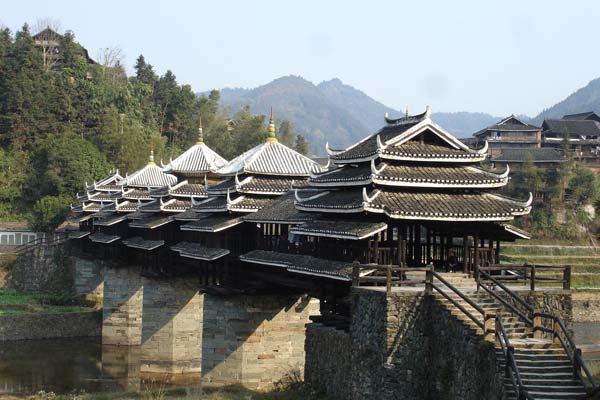
Sanjiang Chengyang Wind and Rain Bridge

Overview:Chengyang Bridge or Chengyang Wind and Rain Bridge is a bridge in Sanjiang Dong minority county of Liuzhou, Guangxi, China. Completed in 1912, Chengyang Fengyu Bridge, aslo called Yongji Bridge and Panlong Bridge, is the most typical example of several special covered bridge or langqiao in the local Dong minority region.
Chengyang Bridge or Chengyang Wind and Rain Bridge is a bridge in Sanjiang Dong minority county of Liuzhou, Guangxi, China. Completed in 1912, Chengyang Fengyu Bridge, aslo called Yongji Bridge and Panlong Bridge, is the most typical example of several special covered bridge or langqiao in the local Dong minority region.
The bridge is a combination of bridge, corridor, veranda and Chinese pavilion. It has two platforms (one at each end of the bridge), 3 piers, 3 spans, 5 pavilions, 19 verandas, and three floors. The piers are made of stone, the upper structures are mainly wooden, and the roof is covered with tiles. The bridge has wooden handrails on both sides. The bridge has a total length of 64.4 meters, and its corridor has a width of 3.4 meters. The net height above the river is about 10 meters. The bridge serves as the entrance to eight populous villages in Chengyang. As a result, there is substantial daily traffic on the bridge. Guo Moruo, a famous Chinese author, loved the bridge at first sight and wrote a poem for it.
Walking out onto the bridge, you can sit on the bench and appreciate the picturesque scenery. Looking far ahead, you will be intoxicated with what you see: the Linxi River meandering from the horizon; tea trees growing on the hills; local peasants working hard in the fields; and waterwheels turning, sending water cascading down the river.
Entering the Dong villages near Chengyang Bridge, tourists can watch performances by the Dong people in front of the Drum Tower or visit a local family to enjoy the perfect pastoral life and to experience the customs of the Dong people. There are eight famous stockade villages here that offer a peek into the Dong's life and customs. They are Ma'an, Pingzhai, Yanzhai, Chengyang-Dazhai, Pingpu, Pingtan, Jichang and Guandong.
Sanjiang County sits in the cross sections of Guangxi, Hunan and Guizhou provinces. It is home to Dong ethnic minority. The Dong people also erect covered bridges with porches and pavilions which provide shelter even when it rains. The local people call these types of bridges by a beautiful name - 'Wind and Rain' bridges. Of them, the Chengyang Wind and Rain Bridge is famous as the largest well-preserved wind-rain bridge in the world under national key cultural relics protection.
Travel tips:
Hours: all day long
Admission: 60 yuan
Getting there: Take the 'Sanjiang to Chengyang' bus and get off at the Chengyang.
Accommodation: Near the bridge, there are several hostels. If you want to have a spectacular view of the charming scenery, you may want to stay in the Drum Tower Folk Hostel built on the hill.

